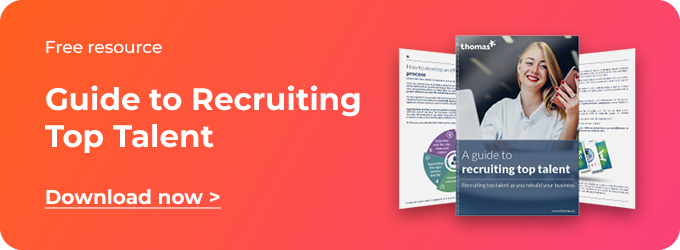Organizations go through phases of requiring new staff members and fulfilling new demand, that’s where ‘Time To Hire’ is introduced by many HR professionals. Time to Hire is one of the most important and frequently used metrics used by recruiters in understanding just how important the correct implementation of this process is can save organizations a lot of time and money.
In this guide we will take a closer look at what Time to Hire is, the Time to Hire Formula, why it is important and how to improve it.
As you will discover in our guide, recruitment metrics play a key role in the proper functioning of a business and its workforce management.
What is time-to-hire?
Time to hire is a common and widely considered important recruiting metric. It measures the number of days between a candidate applying for a job and that same candidate accepting a job offer. The Time-to-hire metric is another way of analyzing how quickly a company can select and hire the best candidate.
From an operational perspective, it can give a clear figure to your HR team just how much time is needed to fill your open job position.
Time-To-Hire has become the metric that many understand in the recruitment world. They form part of the wider metrics which are used, such as:
- Time to fill
Measures the number of days it takes to fill an open position, from the date a job requisition is posted to the date a new hire accepts the position. This metric is often expressed as an average number of days when divided by the total number of hires or positions filled.
- Cost to fill
Which is a calculation that measures internal & external recruiting costs/number of hires.
- Interview to hire ratio
Interview to hire ratio is the number of candidates a hiring manager needs to interview to make an offer. An average interview to offer ratio is about 4.8:1. A good ratio is 3:1 or better.
As a key metric for human resource departments, time-to-hire refers to the amount of time that passes between when a job candidate is initially contacted by a company and when they accept the employment offer.
Time-to-hire is one of the key recruiting and hiring metrics. Time-to-hire shares the pedestal with cost-per-hire and quality-of-hire. These 3 metrics are the most important and most frequently used recruitment metrics.

Time to hire formula
Time to Hire is calculated by using a simple formula which is: The day the candidate accepted the offer - The day the candidate entered the pipeline.
An example of this would be:
- Vacancy posted and promoted on the 1st day of the month
- An application is received on the 10th
- Between the 10th and 24th the candidate undergoes interviews, evaluations etc
- On the 25th - the candidate is provided with a job offer
- They accept the offer on the 28th
- The time between the date on which their application was received (10th) and the date on which they accepted the offer (28th) is the time to hire (18 days)
There has been some confusion in recent years about this calculation, but the example shown above will give the most accurate picture for the time to hire. Of course you can use a modified formula to calculate the average time to hire which is:
Time to hire (1) + Time to hire (2)... / Total number of job positions.
There is also some confusion that exists between the metrics ‘time to fill’ and ‘time to hire’; we will cover this later in the guide.
Why is time to hire important?
So why is Time to Hire important? In essence, it gives you two key insights.
Recruiting efficiency which is the metric that measures the speed at which a candidate is processed, assessed, interviewed, and accepted for a job. The longer the time required indicates a slow and inefficient process with unnecessary bottlenecks.
Candidate experience is based on the metric of how long your candidate will choose to join your organization. Naturally, candidates would have a time to hire for two weeks rather than two months. A faster time to hire will lead to a better candidate experience.
Whilst these two insights alone give you great detail, mainly about the experience you are having and providing they also inadvertently offer more. The first is the indication of recruitment costs - as longer time to hire increases recruitment costs and raises the possibility of losing top candidates.
The second is just how much “candidate perception” of the organization is either positive or negative. Research has indicated that around 57% of job seekers lose interest if the recruitment process takes too long and this can reflect very negatively on the organization as a whole.
Time to hire vs time to fill
As previously mentioned, there has been a lot of confusion in recent years regarding Time to Hire vs Time to Fill. Not only are they different, they can have an impact when used incorrectly.
They are both valuable metrics and HR departments can learn a lot from using these metrics. Time-to-hire refers to the total time it takes for a prospective candidate to apply until the second they accept a job offer, the Time-to-fill metric can be used to track the total amount of time company positions remain unfilled.
As discussed, they can both be essential metrics for an organization and they can be tracked and calculated differently to highlight efficiency processes.
Unlike the time-to-hire formula, the time-to-fill formula can vary depending on when the HR manager wants to begin measuring the time period. This could be from when a job opening is submitted for approval or when the job opening is actually approved, or when the job opening is first advertised. The end variable is the same as time-to-hire when a candidate accepts the job offer.
By using both metrics, you can develop a clearer understanding of what can be improved in the hiring process and in the different stages. Time to Hire will be focused on the time between a candidate applying and accepting an offer whilst Time to Fill can look at more of the internal metrics i.e. approval for a role posting.

How to improve time to hire
We all want to have the best teams and every organization wants to have the best candidates apply. Time to Hire is important for the experience of candidates and ensuring top talent isn’t lost due to delays.
Another important reason to get Time to Hire done correctly is that it is an important exercise in saving costs - so what can be done to improve time to hire?
Here are just a few practical ways to shorten time-to-hire:
- Use efficiency improving recruitment tool
- Many of the very good tools on the market today will allow you to excel at the recruitment of staff by significantly contributing towards minimizing time to hire and maximizing the quality of candidate experiences.
- From email automation to letting the candidate know where they are in terms of the process, you can give a better representation of the organization and the recruitment process without having to do much other than set up a whole system.
- Assess all stages of the recruitment funnel
- Using the metrics identified previously, you can discover where the pinch points are in the recruitment process and make the necessary improvements to achieve a better outcome.
- Use both the Time to Hire and the Time to Fill calculations (as averages) to see where you can improve.
- Allocate realistic time periods to every stage of the process
- You need to be realistic with how long it can take to fill a position. You may have a very niche role or industry and the requirements of certain candidates may be completely different to more standard roles.
- An aspect of recruitment efficiency optimization can be to allocate appropriate periods of time to each stage which can then highlight where delays are occurring.
- This refers to the development of a structured hiring process.
- Improve your Employer Brand and careers page
- Candidates are likely to visit and review the company careers information multiple times during the hiring process.
- Employer branding describes an employer's reputation as a place to work and their employee value proposition.
- You want to be able to attract the best talent and one of the ways of doing this is by showing potential employees what the values and the culture of the organization are and how staff appear to feel about working there. Employer Brand, conveyed from this resource, alongside other information that keeps candidates on board.
- By improving the company careers page - fewer applicants will drop out or reject job offers.
- Present all of the information applicants typically seek - from the careers page into platforms which they will visit alongside your website.
- Use pre-employment candidate assessments and tests
- It takes time to administer cognitive ability assessments - the best solutions are efficient and effective.
- They enable the best, most suitable candidates to be identified quickly - and can contribute toward reducing time to hire.
In summary
Recruitment metrics can help organizations get a firm understanding of where they can be better at recruiting top talent. The longer you may good people wait, the worse the outcome. Understanding Time-to-Hire is one of the best ways to get an idea of what you can do better as an organization to get your perfect candidate.
The Thomas Recruitment Platform can help not only identify the right candidates for your organization but also administer assessments and speed up the recruitment process by automating many of the required processes.





